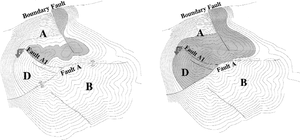Fault control on hydrocarbon distribution
| Exploring for Oil and Gas Traps | |

| |
| Series | Treatise in Petroleum Geology |
|---|---|
| Part | Predicting the occurrence of oil and gas traps |
| Chapter | Evaluating top and fault seal |
| Author | Grant M. Skerlec |
| Link | Web page |
| Store | AAPG Store |
Faults control both the vertical and lateral distribution of hydrocarbons within fields. Some compartments and sands are dry; others contain subeconomic accumulations. Risking percent fill using fault seal analysis helps avoid needless wells.
Distribution example
Figure 1 is an example of faults controlling the distribution of hydrocarbons within a Gulf Coast field. The field contains 33 separate reservoir sands. At each mapped reservoir level, the field is divided into three major compartments (A, B, D) by faults. Compartment D is almost always empty, while the other compartments commonly contain hydrocarbons. In only 5 of the 33 reservoirs does Compartment D contain hydrocarbons.
Compartment D is commonly empty because a series of juxtaposed lithology leak points (JLLP) along the western portion of Fault A allows hydrocarbons to leak into Compartment B and then across the eastern portion of Fault A into the next highest reservoir. Only when Fault A is cross sealing does Compartment D contain hydrocarbons. Cross seal is created by shale-prone gouge with low shale gouge ratios (SGR) or sand and shale juxtaposition.
Assessing percent fill
Despite numerous examples of this type, we often erroneously assign an equal chance of some specific percent fill when assessing a prospect's reservoirs and fault compartments. We must understand the following:
- All reservoirs in a series of stacked sands do not have the same chance of being filled with hydrocarbons.
- Each fault compartment of a single reservoir does not have the same chance of being filled with hydrocarbons.
- We can predict (before drilling) which sands and fault compartments contain hydrocarbons and which are dry.
Communication of fluids across faults
Understanding communication of fluids across faults lets us develop fields more efficiently. Routine fault seal analysis during production avoids needless wells and helps us position necessary infill wells for producing residual accumulations. Cross-sealing faults compartmentalize a reservoir. Isolated compartments created by cross-sealing faults require individual production wells. In contrast, cross-leaking faults allow some fault-bounded compartments to be produced from adjacent compartments and additional wells may be unnecessary.
See also
- Reservoir simulations and field unitization
- Fault seal breakdown during production
- Percent fill: controlling factors
- Fault seal behavior
- Cross-leaking faults
- Cross-sealing faults
- Dip-sealing faults
- Dip-leaking faults
